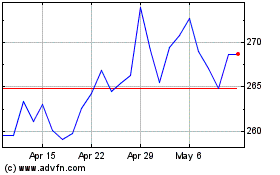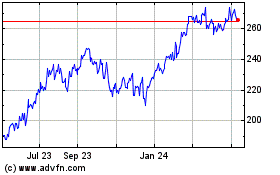Merrill Lynch to End Commission-Based Options for Retirement Savers
October 06 2016 - 5:30PM
Dow Jones News
Retirement savers who work with Merrill Lynch will no longer be
able to pay their broker a commission, the latest example of how
new rules on retirement accounts are roiling the wealth-management
industry.
The Bank of America Corp. brokerage unit told its more than
14,000 brokers on Thursday that after April 10 investors who want a
retirement account at Merrill will need to pay a fee based on a
percentage of their assets, instead of having the option of being
charged for each transaction made in their account.
Merrill is making the change to comply with the Obama
administration's so-called fiduciary rule requiring brokers to put
the interests of retirement savers ahead of their own. The rule is
expected to affect less than 10% of Merrill's $2 trillion in client
assets, Bank of America Chief Financial Officer Paul Donofrio told
analysts in April.
"We believe these decisions best position us to meet the
responsibilities required by the fiduciary rule," a Merrill
spokeswoman said.
Merrill investors in nonretirement accounts won't be affected by
the changes.
Merrill is the first brokerage to take the step of eliminating a
commission-based account option for retirement investors who want
to work with a broker. St. Louis-based brokerage Edward Jones and
independent broker-dealer LPL Financial Holdings Inc. are the only
other major brokerages to detail their postretirement rule business
plans, with both still offering some sort of commission-based
option to retirement savers.
Merrill's approach to compliance could serve as a template for
its biggest rivals, such as Morgan Stanley and Wells Fargo &
Co.'s brokerage arm, according to Alois Pirker, a research director
at Boston consulting firm Aite Group. That is because those firms,
including Merrill, have more high-net-worth clients who may already
work with a broker through a fee-based account.
"This requires that clients engage with the firm fully," Mr.
Pirker said. "If the client isn't willing to do that, they will
need to look for different options."
The rule is expected to affect about $3 trillion of client
assets in the U.S., according to researcher Morningstar Inc.
Write to Michael Wursthorn at Michael.Wursthorn@wsj.com
(END) Dow Jones Newswires
October 06, 2016 17:15 ET (21:15 GMT)
Copyright (c) 2016 Dow Jones & Company, Inc.
LPL Financial (NASDAQ:LPLA)
Historical Stock Chart
From Mar 2024 to Apr 2024

LPL Financial (NASDAQ:LPLA)
Historical Stock Chart
From Apr 2023 to Apr 2024
